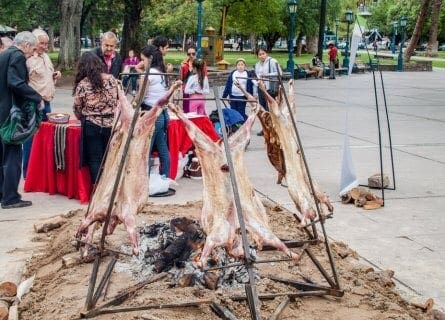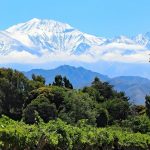Mendoza Travel Guide
Where Desert Beauty Meets Vineyard Elegance - Experience Argentina's Hidden Gem!
The Mendoza region is perhaps the world’s most famous piece of desert landscape. It is home to two of Argentina’s major claims to fame – the Andes mountain range and wine. Many visitors get lost for weeks in the region, and with good reason; who could resist lively and cosmopolitan Mendoza or the surrounding area, which boasts hundreds of wineries, often attached to luxury hotels, spas, and gourmet restaurants? Yet there is much to enjoy in the city itself; without venturing to the great plains – a bustling city of wide, leafy avenues, atmospheric plazas, and superlative restaurants, Mendoza is an addictive proposition. Even if you only give it a day or two on your itinerary, we guarantee you’ll be back for more.
Mendoza’s Rich Historical Tapestry
Mendoza’s history is complex and fascinating. Before the first Europeans arrived in the 16th century, many different native peoples ranged throughout what became Argentina. Until Europeans tragically wiped out many tribes, there were indigenous inhabitants as far south as Tierra del Fuego (Land of Fire) in Patagonia. But, just over a decade after Christopher Columbus accidentally encountered the Americas, other European explorers began probing the Rio de la Plata estuary. Most early explorers were motivated by legends of vast quantities of silver.
The first genuine attempt at establishing a permanent settlement in Argentina – in what is now present-day Buenos Aires – was made by Pedro de Mendoza in 1536. However, his attempt failed, and it wasn’t until 1561 that Mendoza was founded by the conquistador Pedro de Castillo. Interestingly, Mendoza was part of present-day Chile until 1776, controlled under the jurisdiction of the Spanish territory “Captaincy General of Chile.” That year, Spain made Buenos Aires the capital of the new viceroyalty of the Rio de la Plata, including Paraguay, Uruguay, and Mendoza.
Unfortunately, the new viceroyalty had internal disputes over trade and control issues. Still, the response was unified when the British raided Buenos Aires in 1806 and again in 1807 (in an attempt to seize control of the Spanish colonies). Locals rallied against the invaders without Spanish help and chased them out of town!
Meanwhile, Mendoza’s growing population was becoming restless. Initially governed as part of a broader jurisdiction, which included the province of Tucuman, in 1813, the region became part of the Province of Cuyo, a much smaller regional jurisdiction with far greater autonomy.
Mendoza in the 19th Century: A Time of Change
Indeed, the 19th century was a very turbulent time for Argentina. Toward the end of the 18th century, criollos (Argentine-born colonists) became increasingly dissatisfied with Spanish authority. After Napoleon invaded Spain in 1808, Buenos Aires dared to declare itself independent in 1810. However, the troubles didn’t end there. United in name only and lacking a central authority, the various provinces began to clash, and conflict ensured for over 20 years. Argentine politics was divided between the interior Federalists and the Unitarists of Buenos Aires, who upheld the city’s central authority. Then, in 1820, Mendoza decided to isolate itself further and parted ways with the provinces of San Luis and San Juan, formerly part of the province of Cuyo, which included Mendoza.
The Birth of Argentina’s Wine Industry
In the 1860s, Argentina elected its first official president, Bartolome Mitre. His goals were to build a united nation and to develop Argentina’s infrastructure. There were problems and conflicts during his presidency, but overall, the late 19th century was a stable and prosperous era for the citizens of Mendoza. The economy boomed, and immigrants poured in from Europe – by the turn of the 20th century, Argentina had a highly developed rail network. In 1885, Mendoza was connected to the capital by rail, which helped to encourage the development of the region’s fledgling wine industry. Yet this century was also a mixed bag; in 1861, a terrible earthquake nearly destroyed the city of Mendoza, which had to be almost entirely rebuilt.
Nevertheless, this period saw the development of what is today arguably Argentina’s most famous export. Since the Jesuits planted vines in northern Argentina more than 500 years ago, Argentine wine has gone from strength to strength. Historically, the first major changes occurred when many European immigrants arrived in the 19th century. With them came new ideas, grape varieties, and techniques, all of which helped to propel Mendoza’s industry into the vibrant state it enjoys today.
The 20th century, however, was a time of great political and social upheaval across Argentina. The rise of Juan Peron and his famous wife Evita, numerous economic recessions, the Falklands War, and the rise of a military dictatorship – and the subsequent return to democracy – were all part of Argentina’s colorful and turbulent 20th-century history.
Mendoza Today: A Desert Oasis with Vibrant Nightlife
Today, though, one detects a tangible sense of optimism, rather than pessimism, in the streets of Mendoza. Ostensibly, it’s a desert town, though you wouldn’t know it – acequias (irrigation channels) run beside the roads, and glorious fountains adorn the plazas. Lively during the day, Mendoza’s USP is its outstanding nightlife and citizens an unparalleled sense of joie de vivre. At night, the city comes into its own when the bars and restaurants of central Mendoza overflow onto the sidewalks. But the real beauty of this captivating city is its diversity and enviable location – if you can bear to put your glass down for a minute, there’s plenty more to keep you busy. Just down the road is Cerro Aconcagua, America’s highest peak, while outdoor-nuts will love the bewildering array of activities. Bored in Mendoza? It’s extremely unlikely, to say the least.
-

Barbecue of a lamb Gastronomy & Wine
If there is one overarching symbol of Argentine gastronomy, it is undoubtedly the asado (BBQ). Indeed, Argentines are artists at the grill, and it’s no exaggeration to say that meat is a massive part of the daily diet. Argentine beef is considered the best in the world and at the top of the culinary hierarchy. When the first Spaniards came to Argentina, they brought cattle, and this tradition of rearing cows for slaughter eventually became an integral part of local food culture. Today, the average Mendoza inhabitant consumes over 59kg of beef annually – impressive! But then, who could resist the aromas of Bife de Chorizo (Sirloin steak) cooking over a sizzling grill while your host offers you a glass of Malbec?
Of course, beef has no monopoly over Argentina’s innumerable parrillas (steak restaurants). In Mendoza, chefs pride themselves on chivito (young goat), which is perfectly grilled. Empanadas – small, stuffed pastries – are ubiquitous in Mendoza and are typically filled with minced beef or sometimes lamb, although this is more common in Patagonia. They make for a delicious, tasty snack.
However, the culinary world in Mendoza doesn’t just revolve around delicious cuts of grilled meat, moreish though they are. Thanks to Argentina’s Italian heritage, Italian immigrants, who settled in the late 19th century, have heavily influenced the national cuisine. As a result, pasta is heavily featured in cities such as Mendoza, with local chefs adding their creative touches to classic Italian dishes.
Nevertheless, the undisputed highlight of any trip to Mendoza is the magnificent and seemingly endless quantities of fine wine. Mendoza is now globally synonymous with wine, as vineyards stretch out in all directions in the Luyan de Cuyo region. Velvety, sublime Malbec is the apparent draw and Argentina’s most important grape variety. Whether by accident or design, we all now associate Argentina with lush, rich, and impeccably balanced Malbec – the ideal foil to local cuisine. It has long been one of our favorite wine styles.
But take the time to explore this stunningly beautiful country’s potential, and you’ll discover a varied wine industry brimming with premium and diversified wine styles. Bodegas Riglos, founded in 2002 by Dario Werthein, is one such bodega (winery) providing hard evidence that Mendoza, or Argentina, does not begin and end with Malbec. Their Cabernet Franc is justly celebrated, offering intensity, deep red fruit, freshness, and potent aromas by the bucket load. The Cabernet Sauvignon, Syrah, Bonarda, smaller amounts of Chardonnay, and Sauvignon Blanc grown across Mendoza are similarly excellent. Proof that even if you’re tired of Malbec, Mendoza can still deliver.
One trick pony? No way!
Highlights
-
Parque General San Martin
A lovely haven of tranquility, the Parque General San Martin offers a welcome rest-bite from the summer heat. Walking along the lakeshore and snoozing in the shade of the rose garden in this beautiful park is a great way to enjoy one of the city’s highlights.
-
Iglesia, Convento y Basilica de San Francisco
This is Mendoza’s most important religious building. Many people consider the image at this church miraculous because it survived the terrible earthquake of 1968. Of particular note is the Virgin’s semicircular chamber, where visitors leave tributes to her and San Jose de San Martin, the general who liberated Argentina from the Spanish.
-
Museo Fundacional
This fascinating museum, protects excavations of the colonial cabildo (town council) destroyed by an earthquake in 1861. At that time, the city’s geographical focus shifted west and south of its present location. A series of detailed exhibits depicts Mendoza’s colorful history.
Recommended for you
More information
If you would like us to customize an exclusive luxury tour, contact us and let us know your travel plans. We offer luxury food and wine tours for private groups of a minimum two guests. In addition, all of our private, chauffeured tours are available year-round upon request.


